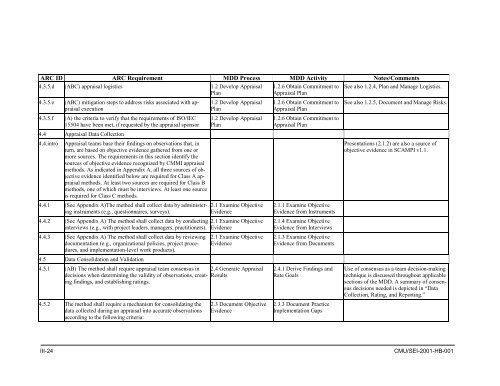Standard CMMI Appraisal Method for Process Improvement (SCAMPI)
Standard CMMI Appraisal Method for Process Improvement (SCAMPI)
Standard CMMI Appraisal Method for Process Improvement (SCAMPI)
Create successful ePaper yourself
Turn your PDF publications into a flip-book with our unique Google optimized e-Paper software.
ARC ID ARC Requirement MDD <strong>Process</strong> MDD Activity Notes/Comments<br />
4.3.5.d (ABC) appraisal logistics 1.2 Develop <strong>Appraisal</strong> 1.2.6 Obtain Commitment to See also 1.2.4, Plan and Manage Logistics.<br />
Plan<br />
<strong>Appraisal</strong> Plan<br />
4.3.5.e<br />
4.3.5.f<br />
(ABC) mitigation steps to address risks associated with appraisal<br />
execution<br />
(A) the criteria to verify that the requirements of ISO/IEC<br />
15504 have been met, if requested by the appraisal sponsor<br />
4.4 <strong>Appraisal</strong> Data Collection<br />
4.4.intro<br />
<strong>Appraisal</strong> teams base their findings on observations that, in<br />
turn, are based on objective evidence gathered from one or<br />
more sources. The requirements in this section identify the<br />
sources of objective evidence recognized by <strong>CMMI</strong> appraisal<br />
methods. As indicated in Appendix A, all three sources of objective<br />
evidence identified below are required <strong>for</strong> Class A appraisal<br />
methods. At least two sources are required <strong>for</strong> Class B<br />
methods, one of which must be interviews. At least one source<br />
is required <strong>for</strong> Class C methods.<br />
4.4.1 (See Appendix A)The method shall collect data by administering<br />
instruments (e.g., questionnaires, surveys).<br />
4.4.2 (See Appendix A) The method shall collect data by conducting<br />
interviews (e.g., with project leaders, managers, practitioners).<br />
4.4.3 (See Appendix A) The method shall collect data by reviewing<br />
documentation (e.g., organizational policies, project procedures,<br />
and implementation-level work products).<br />
4.5 Data Consolidation and Validation<br />
4.5.1 (AB) The method shall require appraisal team consensus in<br />
decisions when determining the validity of observations, creating<br />
findings, and establishing ratings.<br />
4.5.2 The method shall require a mechanism <strong>for</strong> consolidating the<br />
data collected during an appraisal into accurate observations<br />
according to the following criteria:<br />
1.2 Develop <strong>Appraisal</strong><br />
Plan<br />
1.2 Develop <strong>Appraisal</strong><br />
Plan<br />
2.1 Examine Objective<br />
Evidence<br />
2.1 Examine Objective<br />
Evidence<br />
2.1 Examine Objective<br />
Evidence<br />
2.4 Generate <strong>Appraisal</strong><br />
Results<br />
2.3 Document Objective<br />
Evidence<br />
1.2.6 Obtain Commitment to<br />
<strong>Appraisal</strong> Plan<br />
1.2.6 Obtain Commitment to<br />
<strong>Appraisal</strong> Plan<br />
2.1.1 Examine Objective<br />
Evidence from Instruments<br />
2.1.4 Examine Objective<br />
Evidence from Interviews<br />
2.1.3 Examine Objective<br />
Evidence from Documents<br />
2.4.1 Derive Findings and<br />
Rate Goals<br />
2.3.3 Document Practice<br />
Implementation Gaps<br />
See also 1.2.5, Document and Manage Risks.<br />
Presentations (2.1.2) are also a source of<br />
objective evidence in <strong>SCAMPI</strong> v1.1.<br />
Use of consensus as a team decision-making<br />
technique is discussed throughout applicable<br />
sections of the MDD. A summary of consensus<br />
decisions needed is depicted in “Data<br />
Collection, Rating, and Reporting.”<br />
III-24<br />
CMU/SEI-2001-HB-001
















